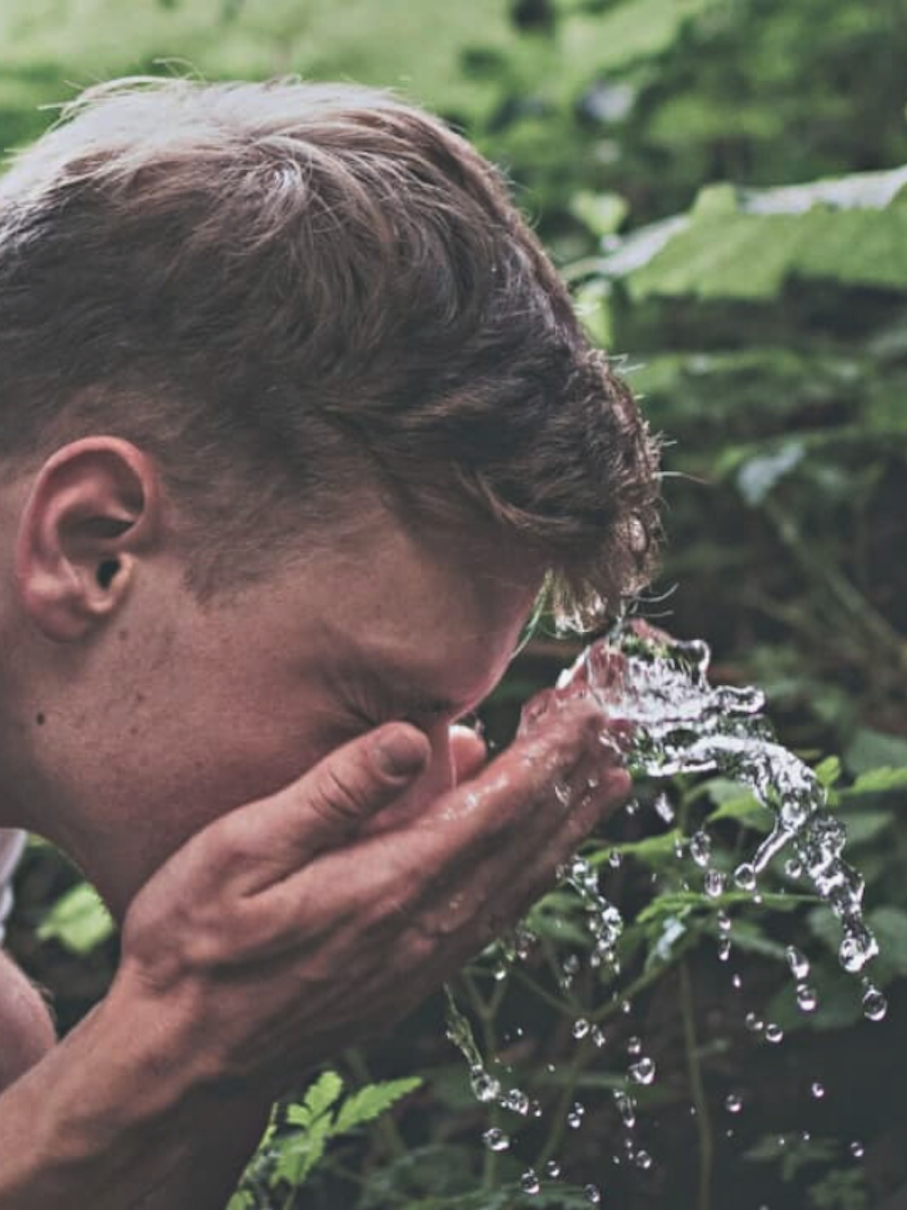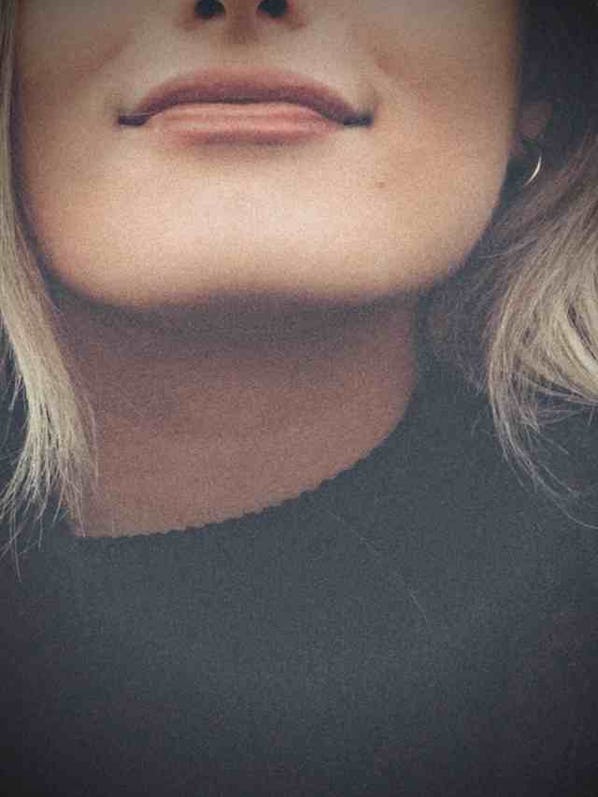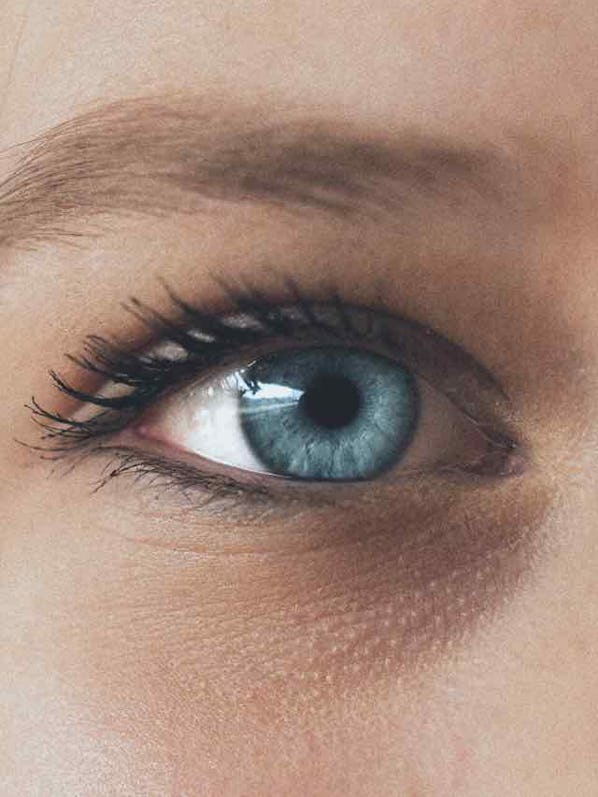
Foods & Supplements for Healthy Eyes

Dry Eyes - Lasting Relief
Makeup today contains preservatives, antioxidants, humectants, fragrances, ultra-violet absorbers, emollients, emulsifiers, acrylates, and dyes – all of which can cause reactions or trigger longer-term health risks with your eyes.
Our eyes and the area around the eyes (known as the periorbital region) are more susceptible to damage because of their anatomy and complex physiology.
Long-term or excessive use of eye makeup can inflame your eyes, affecting the quality of your tears and leading to or making dry eyes worse.

In your twenties, your skin is typically at its peak in terms of elasticity and collagen production. However, this is also when many people start using makeup regularly. Continually applying and removing makeup can cause the skin around your eyes to dry and irritated. This is especially true if you’re not diligent about removing your makeup before bed or using harsh products.
Over time, this can lead to premature ageing and the early onset of fine lines and wrinkles. To minimise these risks, it’s crucial to establish good habits early. Always remove your makeup before bed, use gentle, hypoallergenic products, and moisturise regularly to keep the skin around your eyes hydrated and healthy.
As you move into your thirties and forties, the skin around your eyes becomes thinner and more delicate. This makes it even more susceptible to damage from makeup application and removal. Additionally, the risk of developing infections from using old or contaminated makeup increases during this period. Bacteria can quickly grow in makeup products like mascara and eyeliner, especially those used around the eyes.
These infections range from minor irritations to serious conditions like conjunctivitis or keratitis. To protect your eye health, it’s essential to regularly clean your makeup tools and replace your makeup every few months. Also, consider switching to hypoallergenic makeup products that are less likely to cause irritation or allergic reactions.
In your forties and fifties, the effects of long-term makeup use can become more noticeable. The skin around your eyes may show premature ageing, with more pronounced wrinkles and fine lines. Additionally, the risk of developing Dry Eye Syndrome increases during this period.
Certain makeup products, especially powder-based ones, can exacerbate this condition, as they can dry out the eyes. To preserve your eye health, using cream or liquid-based makeup products that are less likely to cause dryness is recommended. Also, consider using an eye cream or serum that contains ingredients like hyaluronic acid or ceramides, which can help to hydrate the skin and reduce the appearance of wrinkles.
As you move into your sixties and beyond, taking care of your eye health becomes even more critical. The skin around your eyes is at its thinnest and most delicate, making it more susceptible to damage. Age-related eye conditions like Cataracts and Age-related Macular Degeneration (AMD) have become more common. To protect your eyes, it’s important to continue following the practices established in earlier years - removing makeup before bed, cleaning makeup tools regularly, and replacing makeup every few months. Also, consider having regular eye check-ups to catch any potential issues early.
If you have sensitive eyes, selecting makeup products to minimise irritation is crucial. This typically means opting for both hypoallergenic makeup and free from added fragrances (minimising adverse reactions and keeping your eyes irritation-free).
Waterproof mascara can be a problem for sensitive eyes. This is because it often requires more effort to remove, which can lead to unnecessary rubbing and tugging at the delicate skin around your eyes. This can cause irritation and even lead to premature fine lines and wrinkles. Opt for mascaras that are easily removed with a gentle makeup remover.
When applying your eye makeup, steer clear of your waterline (the edge of your eye where your eyelid meets your eyeball). Using makeup here can block the tiny oil glands that protect your eye’s surface. These glands produce oil that forms part of your tear film, which keeps your eyes lubricated and comfortable. When they’re blocked, it can lead to dryness and irritation.

Always put your contact lenses in before applying makeup to avoid getting any on the lenses. This avoids getting any makeup residue on your lenses, which can cause discomfort and potentially lead to eye infections. Avoid using powder-based makeup, which can get into your eyes and onto your lenses.
When applying makeup, wash your hands thoroughly so they’re free from dirt and bacteria (preventing eye infections). Then, apply your makeup carefully, avoiding the waterline, as this can block oil glands that protect your eye’s surface. Also, avoid ‘pumping’ the wand when using mascara, which can introduce bacteria into
When removing makeup, take out your lenses first to avoid damaging them. This also prevents makeup remover from getting onto your lenses, which can cause them to become cloudy or discoloured. Use a gentle makeup remover designed for sensitive eyes, and thoroughly clean your face to remove all traces of makeup.

One of the most important practices in maintaining eye health when using makeup is regularly cleaning your makeup brushes. If not properly cared for, these tools can become a breeding ground for bacteria. This bacterial build-up can then be transferred to your eyes, leading to infections or irritations. Therefore, cleaning your brushes at least once a week is crucial. Use a gentle brush cleaner or a mild shampoo, rinse thoroughly, and allow them to air dry. This practice not only helps to protect your eyes but also extends the life of your brushes and ensures better makeup application.
While lending your mascara or eyeliner to a friend might seem harmless, sharing eye makeup can spread bacteria and infections. Each person has unique bacteria on their skin, including around the eyes. When you share makeup, you also share these bacteria, which can lead to conditions like conjunctivitis or styes. To maintain the health of your eyes, make it a rule to keep your makeup to yourself.
Mascara, in particular, can be a hotbed for bacteria. This is due to the nature of its application - each time you pull the wand out and expose it to air, bacteria can latch on and then get pushed back into the tube, creating an environment for them to multiply. Using old, potentially contaminated mascara can lead to eye infections. Therefore, replacing your mascara every three months is recommended, or sooner if it starts to dry out or smell different. This practice ensures that you’re not exposing your eyes to unnecessary risks.
Applying makeup in a moving car might seem like a time-saver, but it’s a practice that can lead to eye injuries. If the car makes a sudden stop or an unexpected turn, you could end up poking your eye with a mascara wand or eyeliner pencil. These injuries can range from minor scratches to serious corneal abrasions. To protect your eyes, always apply makeup in a stable, stationary environment where you control your movements.
Leaving makeup on your eyes overnight can lead to many problems, including eye infections, eyelash breakage, and premature skin ageing around your eyes. Makeup can clog your eyelids’ tiny hair follicles and oil glands, leading to painful styes or chalazion. Mascara and eyeliner can also flake off at night and end up in your eyes, causing irritation or infection. Therefore, always make it a point to remove all makeup before bed using a gentle, oil-free makeup remover or cleanser.
Just like food, makeup also has an expiration date. Using expired makeup can lead to skin irritation, breakouts, and eye infections. Over time, makeup can break down, harbour bacteria, and lose effectiveness. Pay attention to the expiration dates on your makeup products and replace them as needed. If a product doesn’t have a specific expiration date, a general rule of thumb is to replace eye makeup every three months, foundations and lipsticks every year, and powders every two years.
Our Drops, Spray and Vitamins strengthen your tears and maintain a healthy tear film.
Physical injury. Good quality tears and a healthy tear film can help your eyes recover after physical trauma or injury.
Infections. Good quality tears and a healthy tear film provide a natural barrier against infections (pathogenic damage).
Chemical Damage. Our Eye Drops and Spray are preservative-free, provide relief and help wash out your eyes when exposed to hazardous chemicals.
Waterproof makeup has its advantages - particularly when it comes to those teary moments or those intense, sweaty workout sessions. It’s designed to stay put, resisting smudging and running, which is great for maintaining your look. But waterproof makeup can be pretty tough on your eyes.
The process of removing waterproof makeup often involves a fair amount of rubbing. This can be particularly damaging to the delicate skin around your eyes, which is thinner and more sensitive than the rest of your face. Over time, this vigorous rubbing can develop fine lines and wrinkles, leading to premature ageing.
It’s crucial to invest in a makeup remover that’s specifically designed to tackle waterproof makeup. These removers are formulated to dissolve the resilient ingredients in waterproof makeup, allowing for easier removal. Look for a gentle and effective product that can remove your makeup thoroughly - without causing unnecessary stress to your skin.

Three types of damage and injury could be caused by eye makeup.
Perimenopause and Menopause make women more susceptible, as they are more likely to suffer from dry eyes and poor-quality tear production. The risk of these increases with age. Read on to understand the risks and, most importantly, how to protect your eyes.

Physical injuries are caused by a direct impact to the eye - ranging from mild to severe. Some common examples:
• Removing makeup with excessive force can damage your lashes. (Commonly seen with waterproof makeup.)
• Eyeliner can block your meibomian glands (which run along the edge of your eyelids next to your eyelashes).
• Scratching your eyes with a sharp pencil eyeliner.
• Poking your eye while applying mascara.
• Spilling eyeshadow over your eyes affects your tears and disrupts your tear film.
• Artificial lashes affect your lashes' natural ability to repel dust and maintain tear film stability.
• Eyelash extensions can cause your eyelashes to fall off.

Eye makeup increases the risk of infections (especially if you suffer from dry eyes). What to watch out for:
• Poor personal hygiene. Make sure you’ve got clean hands, surfaces, and applicators.
• Don’t share makeup.
• Old makeup is a breeding ground for bacteria. Make sure you update your makeup every few months.
• Don’t modify your makeup. Not even adding water to your mascara.
• As we age, we all get Demodex mites on our eyes. (Demodex is a parasite that blocks ducts in your eyelashes – making them itchy and producing dandruff.) Oil-based eye makeup and people with dry eyes show higher rates of Demodex mites.
• Applying makeup to open wounds is an infection risk.

Some chemicals in your makeup can cause inflammation. Some chemicals (including parabens, phenoxyethanol, and chlorphenesin) can damage your meibomian glands - which lie along the edge of the eyelids next to your eyelashes. This can lead to dry eyes and dry eye disease.
Like the skin across the body, your eyelids can develop contact allergies when exposed to allergens (preservatives, fragrances, additives, and colour pigments). Over time this leads to rashes, blisters, and itchy, burning skin.
Preservatives in eye makeup can cause inflammation.

Makeup brushes can harbour bacteria and fungi, leading to eye infections if they come into contact with your eyes.
To clean your brushes, wet the bristles under lukewarm water, apply a small amount of gentle soap, and gently massage the bristles. Rinse under water until it runs clear, then gently squeeze out any excess water and reshape the brush. Leave it to dry naturally overnight.

When selecting eye makeup, especially for those with sensitive eyes or who wear contact lenses, look for hypoallergenic and fragrance-free products - less likely to cause irritation or allergic reactions.
Additionally, opt for products tested by ophthalmologists and avoid parabens and phthalates - preservatives in cosmetics that can cause irritation or other adverse reactions.
For contact lens wearers, choosing oil-free makeup products is particularly important. Oil-based products can leave a residue on your lenses, blurring your vision and making your lenses uncomfortable.
Lastly, always remove your makeup before going to bed. This is crucial - leaving makeup on overnight can lead to clogged oil glands and potential infections. So, no matter how tired you may be, take the time to properly cleanse your face and remove all makeup before you hit the pillow.

As consumers become more conscious of the ingredients in their products, many are turning to natural alternatives. Brands now offer organic and natural makeup products free from harsh chemicals.
These products use ingredients derived from plants and minerals, which can be gentler on the eyes. However, it’s important to remember that ‘natural’ doesn’t always mean ‘safe’, so always check the ingredients and do a patch test before using a new product.

Mascara makes the eyes appear bigger and form an intense look by darkening, stretching, and thickening the eyelashes. Mascara has been produced in various forms, including cakes (or blocks), creams, gels, and low-viscosity liquids.
Eyelash dye and tint involve the application of permanent and semi-permanent colourants onto the lashes to make them appear darker and thicker. The colour can last several weeks (tinting) or longer (dyeing).
Eyelid makeup enhances your eyes - making them look big, bold, and attractive. The most popular products in this category are eyeliner and eyeshadow. Eye makeup remover products may be applied to make them more easily wiped off.
Eyeliner is used to make the eyes bolder with illusive shapes and sizes. Based on fashion trends, it is applied outside the lash line, on the inner lid area closer to the eye, or along the waterline. Eyeliner can be found in a cake, liquid, cream/ gel, or pencil with different formulations.
Eyeshadow is applied to eyelids and below the eyebrows to create depth and dimension to the eyes, making them and their colour stand out and become more attractive. Compared to other facial make-up products, the formulation of eyeshadows requires special care to prevent scratches, infections, irritation, and toxic effects due to soft-thin skin type and proximity to the eyes.
Eye makeup remover helps eye makeup to be more easily wiped off. The remover comes in different forms, including oils, creams, balms, and foams. Chemically, such removers follow the general principle of solubility referred to as “like dissolves like”, in which substances with similar chemical characteristics are dissolved in each other. Therefore, water alone cannot effectively remove cosmetics containing lipophilic compounds, requiring surfactants/ emulsifiers in oil-based or oil-free formulations.
Also referred to as blepharopigmentation, it has recently gained increasing attention. It removes the need for the daily application of eyeliner makeup and provides wearers with an enhanced dull eye.
Artificial eyelash, adhesive, and remover. Eyelash extensions and false eyelashes create bold and attractive looks by modifying natural lashes’ length, volume, curl, and thickness. Lash extensions are individually ‘stuck to’ the base of each natural lash using a special glue. False (strip) lashes are glued on top of your natural eyelashes. Eyelash extensions are semi-permanent and last for several weeks. False lashes are one-time use with the possibility of being reused 2–3 times.
Preservatives are necessary for most makeup products, including those for the eyes. They prevent the growth of bacteria and fungi, extending the product’s shelf life. However, some preservatives can cause skin irritation or allergic reactions. For instance, parabens, a common class of preservatives, have been linked to skin irritation and more serious health concerns. Another preservative to be cautious of is formaldehyde, which can be released by preservatives like Diazolidinyl Urea. Formaldehyde is a known carcinogen and can cause an allergic skin reaction.
Butylated hydroxyanisole (BHA) and butylated hydroxytoluene (BHT) are preservatives that may act as endocrine disruptors. They are commonly found in eyeliners.
Fragrances are often added to makeup products to make them more appealing to the consumer. However, fragrances are a common cause of allergic reactions. They can cause symptoms such as redness, itching, and swelling. If you have sensitive skin or are prone to allergies, choosing fragrance-free eye makeup products is best.
Aluminium powder is often used in mascara and can cause eye irritation. Long-term exposure to aluminium has also been linked to adverse health effects.
Polybutene is a synthetic polymer commonly used in various cosmetic products, including mascara, due to its adhesive properties. It helps to improve the product’s texture, making it smoother and easier to apply. It also contributes to the product’s longevity, helping the mascara to stay on the lashes for an extended period without smudging or flaking.
However, despite its widespread use, polybutene has been associated with several potential health concerns. The most immediate concern is skin irritation- redness, itching, or swelling. This is particularly true for those with sensitive skin or existing skin conditions.
Beyond skin irritation, there are broader health concerns related to polybutene. While it is generally considered safe for cosmetics, some research suggests it may interfere with hormone function. Specifically, some studies have indicated that polybutene may have oestrogenic activity, meaning it can mimic the effects of estrogen in the body. This could potentially lead to hormonal imbalances, although more research is needed.
flexibility and durability of plastics, are also found in various cosmetic products, including eye makeup. They serve as solvents and fixatives, helping maintain the product’s colour and consistency.
However, their use in cosmetics has raised health concerns. In eye health, phthalates can cause irritation, leading to redness, itching, and watering of the eyes. They can also cause skin irritation, resulting in rashes, dryness, and in some cases, allergic reactions.
Beyond these immediate effects, phthalates have been associated with more severe health issues. They are known endocrine disruptors, which can interfere with the body’s hormonal system. This disruption can lead to various health problems, including reproductive issues and developmental problems in children exposed to these chemicals.
Furthermore, some studies suggest a potential link between phthalate exposure and certain types of cancer. However, more research is needed to confirm these findings. Given these concerns, choosing phthalate-free eye makeup products is advisable whenever possible.
Talc is a common filler ingredient in eyeshadows. However, it may contain the known carcinogen asbestos and is best avoided in cosmetic products. Talc is a mineral used in cosmetics for its absorbent and anti-caking properties. It’s often found in eyeshadows and face powders. However, it’s been linked to respiratory issues when inhaled. There’s also been controversy over the potential contamination of talc with asbestos, a known carcinogen.
Dimethicone, a common ingredient in eyeliners, is a silicone-based polymer known for its smoothing properties. While generally considered safe, it can cause skin irritation in some individuals, leading to redness, itching, or dryness, particularly around the sensitive eye area. More concerning, emerging research suggests that dimethicone might interfere with our endocrine system. It’s thought that the compound could potentially disrupt hormonal balance through skin absorption. However, more studies are needed.
Mineral pigments are naturally derived and are often used in eye makeup. They are generally considered safe and are less likely to cause skin irritation or allergic reactions.
Silica is a mineral found in sand, rock, and mineral ores. In cosmetics, it’s used to improve the texture and spreadability of products. It’s generally considered safe, but inhaling silica powder can cause lung irritation.
Mica is a group of shiny silicate minerals. It’s used in cosmetics for its glittering effect. While mica itself is safe, mining mica has been associated with child labour and poor working conditions.